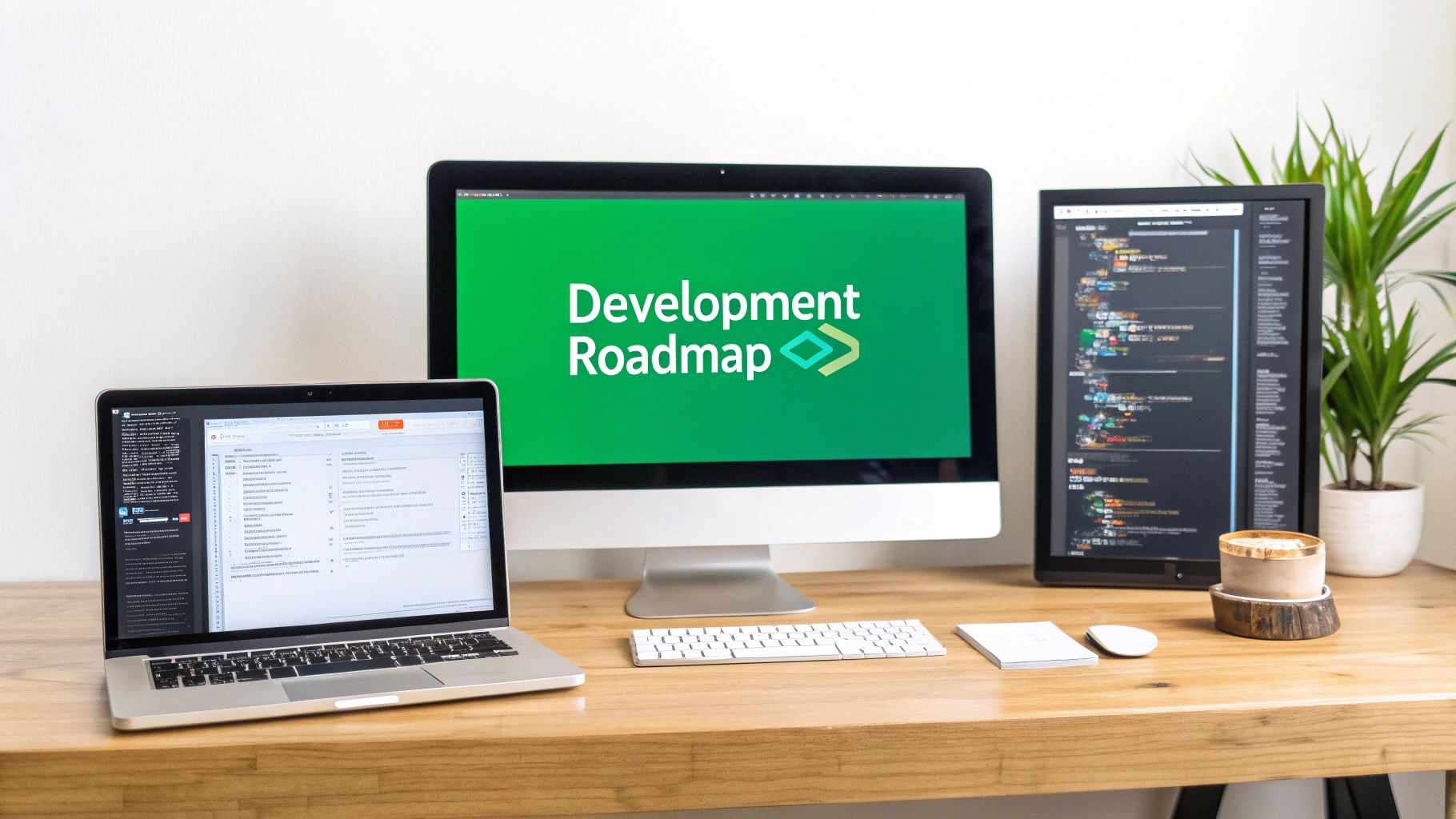Why Your Business Needs a Website Redesign Plan Now

In the fast-paced AE region, your website is often the first point of contact with potential customers. A dated website can negatively impact how people perceive your brand and, ultimately, your profits. An outdated or poorly designed site can lead to missed sales opportunities and a weakened brand image, especially in a tech-savvy market like the UAE.
For instance, slow loading speeds, confusing site navigation, and a design that doesn’t adapt to different devices can frustrate users and send them straight to your competitors.
User expectations are also constantly changing. What impressed users a few years ago might now feel clunky and out of date. This makes a website redesign plan essential for your business strategy. This plan should be comprehensive, covering both visual updates and improvements to how your website functions to maintain a fresh and effective online presence.
Recognizing the Warning Signs
Several warning signs indicate it’s time for a website redesign. A poor mobile experience is a major one. In a region with high mobile usage, a site that isn’t optimized for smartphones and tablets can discourage potential customers. Accumulating technical debt, such as outdated code or plugins, can slow your site down, make it vulnerable to security risks, and difficult to update.
Beyond technical issues, perhaps the most important reason for a redesign is the evolving nature of user expectations. Consumers in the AE region expect sleek, modern, and user-friendly digital experiences. Failing to meet these expectations can damage your brand’s credibility and cost you valuable business.
The impact of design on consumer behavior highlights the importance of website redesign. In the rapidly growing Middle Eastern e-commerce market, a well-designed website can significantly increase conversion rates—by up to 200%. With the Middle East’s e-commerce sector expected to reach $50 billion by 2025, businesses must ensure their websites are attractive and functional. Poorly designed websites can lead to high abandonment rates, with 38.5% of users leaving due to outdated designs. A strategic redesign plan should prioritize engaging user experiences aligned with the region’s digital trends. Find more detailed statistics here: My Codeless Website
The Benefits of a Proactive Approach
Forward-thinking businesses in the AE region are proactively redesigning their websites to stay ahead of the competition. By addressing the issues mentioned above, they improve user experience and boost their search engine rankings. This proactive approach also increases conversion rates and strengthens their brand presence. It demonstrates a commitment to digital excellence, vital for sustained success in today’s competitive market. A well-executed website redesign ultimately leads to tangible business results and positions your company for long-term growth in the dynamic AE digital landscape.
Building Your Website Redesign Framework For Success

A successful website redesign in the AE region requires more than just a visual refresh. It demands a robust website redesign plan, a structured framework built on a strong strategic foundation. This framework ensures your redesign transforms your online presence into a valuable asset. Consider professional web design services when planning your redesign. This isn’t just about a new look; it’s about achieving tangible business results.
Defining Measurable Objectives
Before diving into design, define what success looks like. Establish measurable objectives aligned with your business goals. For instance, if increasing brand awareness is your goal, prioritize improving visibility and engagement metrics.
If you’re aiming to boost sales, prioritize conversions. Focus on streamlined user journeys and clear calls to action. These objectives will guide your redesign, ensuring every decision contributes to meaningful outcomes.
Understanding Your Audience Through Research
Knowing your audience is paramount. Conduct thorough audience research to understand their online behavior, preferences, and pain points. This research shapes design choices, ensuring your website resonates with your target market.
Understanding language preferences, cultural nuances, and device usage is crucial in the AE region. A localized approach maximizes engagement and conversions in this diverse market.
Analyzing The Competitive Landscape
A competitive analysis is essential. Evaluate competitors’ websites to understand their strengths, weaknesses, and strategies. Identify best practices to adopt and areas to differentiate your brand. Understanding how competitors cater to the AE market informs your regional strategy.
Content Audit, Budget, and Team Assembly
A content audit determines which content needs updating, repurposing, or removal. This ensures your website offers fresh, relevant information. A realistic budget prevents cost overruns.
Assembling a skilled cross-functional team is also critical. This team should include members from marketing, design, development, and other relevant departments. A collaborative approach ensures alignment between your website and your business objectives.
To help guide your redesign planning, use the checklist below. It outlines the key components and their importance in the redesign process.
A website redesign involves many moving parts. The following table provides a comprehensive checklist to help you stay organized and on track.
Website Redesign Plan Components Checklist
A comprehensive checklist of essential elements required for a successful website redesign project
| Component | Purpose | Key Deliverables | Timeline Phase |
|---|---|---|---|
| Audience Research | Understand user needs and preferences | User personas, customer journey maps | Discovery |
| Competitive Analysis | Identify opportunities and best practices | Competitor analysis report | Discovery |
| Content Audit | Evaluate existing content and identify gaps | Content inventory, content gap analysis | Strategy |
| Website Design | Create a visually appealing and user-friendly design | Wireframes, mockups, prototypes | Design |
| Website Development | Build a functional and responsive website | Codebase, testing documentation | Development |
| SEO Optimization | Ensure website visibility in search engines | Keyword research, on-page optimization | Development/Launch |
| Content Migration | Transfer existing content to the new website | Content migration plan, updated content | Launch |
| Testing and Quality Assurance | Ensure website functionality and usability | Test cases, bug reports | Launch |
This checklist ensures a structured approach to your redesign. By addressing each component, you set the stage for a successful launch and maximize your chances of achieving your objectives.
Crafting User Experiences for Middle Eastern Audiences

Designing a website for Middle Eastern audiences requires a thorough understanding of the region’s distinct online behaviors and preferences. This goes beyond simply translating content; it involves adapting the entire user experience to resonate with local culture and expectations. A successful website redesign plan considers these factors to connect with the target audience.
Multilingual Implementation: More Than Just Translation
Offering multiple language options is vital in a diverse region like the Middle East. However, true multilingualism goes beyond simple translation. It means adapting the user interface, navigation, and design to suit the cultural context of each language.
Right-to-left languages like Arabic, for instance, require specific adjustments to the website’s structure and visual flow. This thoughtful adaptation not only enhances the user experience but also demonstrates respect for cultural diversity.
Region-Specific Design Patterns for Enhanced Engagement
Middle Eastern users have unique digital habits. Integrating region-specific design patterns can drastically improve website engagement.
Given the exceptionally high mobile usage in the region, prioritizing mobile responsiveness is critical. Incorporating popular social media platforms like Instagram and WhatsApp can also significantly enhance user engagement. These platforms play a key role in online interactions across the Middle East.
Planning a website redesign for the Middle East necessitates understanding the region’s digital landscape. Internet penetration in the United Arab Emirates, for example, is close to 100%, with a significant portion of the population using digital channels for shopping and services. With 73.1% of users abandoning websites due to non-responsive design, prioritizing mobile-first design is paramount. The young, tech-savvy demographic further emphasizes the importance of innovative features and broad device compatibility. To delve deeper into this topic, explore this insightful article: Digital Consumers in the Middle East.
Building Trust Through Cultural Nuances
Cultural sensitivity plays a crucial role in establishing trust with Middle Eastern audiences. A successful website redesign acknowledges and respects religious holidays, cultural sensitivities, and local customs.
Adapting website aesthetics and messaging during Ramadan, for example, demonstrates cultural awareness. These thoughtful considerations can significantly strengthen your brand’s connection with the local community.
Navigation, Content, and Visual Aesthetics
Intuitive navigation, clear content presentation, and visually appealing aesthetics are also essential. Navigation should be user-friendly, regardless of prior experience with your brand. Content should be concise and easy to understand, accompanied by visuals that align with local preferences.
Visuals are powerful tools for conveying your brand message. Consider using culturally relevant imagery and color palettes to resonate with the target audience. These combined elements create a seamless and engaging user experience tailored to the Middle Eastern market. A well-executed website redesign strengthens your brand presence and fosters stronger connections with your target audience in the AE region.
Executing Your Website Redesign With Precision

The execution phase is where your website redesign plan transforms from concept to reality. This stage involves carefully coordinating design and development efforts to bring your vision to life online. This section offers a practical guide to navigate the crucial implementation phases of a successful website redesign, particularly within the AE region.
Information Architecture and Wireframing
A well-defined information architecture is essential for a user-friendly website. It serves as the blueprint, organizing content logically for easy navigation. This allows users to find information quickly and efficiently, enhancing their overall experience.
Wireframing builds upon this structure with visual representations of your website’s layout. These wireframes, often simple black and white outlines, prioritize functionality and user flow. This allows for early feedback and adjustments before the design phase.
Visual Design and Branding
With finalized wireframes, the visual design process takes center stage. This is where your brand’s personality truly shines. The visual design should align with your brand guidelines, using colors, fonts, and imagery that resonate with your brand identity.
Balancing aesthetics with usability is key. The design must be visually appealing yet functional, ensuring a seamless and enjoyable user experience. Prioritizing both form and function will contribute to a successful redesign.
Local Trends and Technologies
When redesigning a website in the Middle East, it’s essential to consider local trends and technologies. The graphic design market in the region is expected to grow at a 3.1% CAGR from 2025 to 2033, emphasizing the importance of visual identity. Middle East and Africa Graphic Design Market Report provides further insights into this growing market. With 91% of MENA consumers purchasing products online, a successful redesign must prioritize visual appeal and seamless online interactions. Furthermore, integrating sustainability into the design can attract environmentally conscious consumers, a growing segment in the region.
Content Migration and CMS Selection
Content migration, the process of transferring existing content to your new website, is a crucial step. Careful planning and execution are necessary to maintain data integrity and prevent content loss. Choosing the right Content Management System (CMS) is equally important.
The ideal CMS should be user-friendly, scalable, and capable of supporting your long-term content strategy. A CMS with robust SEO capabilities is particularly important in the competitive AE digital market, such as WordPress.
Development Workflow and Collaboration
A structured development workflow minimizes errors and ensures efficient project delivery. This workflow should incorporate regular testing and quality assurance checks. Collaboration is vital during this phase, with effective communication between designers, developers, and stakeholders.
Managing stakeholder input without impacting timelines requires clear communication channels and a well-defined feedback process. This helps keep the project on track and addresses potential issues promptly.
Maintaining Momentum and Managing Complexities
Website redesigns can be complex projects with numerous interconnected elements. Maintaining momentum throughout the implementation phase is critical for success. This often involves breaking down the project into smaller, manageable tasks with realistic deadlines. Celebrating milestones along the way can help maintain team morale and motivation.
Practical techniques for managing complexity include using project management tools like Asana or Trello, prioritizing tasks based on business impact, and ensuring open communication within the team.
The following table provides a comparison of different website redesign approaches and their respective timelines.
Website Redesign Timeline Comparison
A comparison of different website redesign approaches and their typical timeline requirements
| Redesign Approach | Planning Phase | Design Phase | Development Phase | Testing Phase | Total Timeline | Best For |
|---|---|---|---|---|---|---|
| Phased Approach | 4-6 weeks | 6-8 weeks | 8-12 weeks | 2-4 weeks | 4-6 months | Complex websites, large organizations |
| Agile Approach | 2-4 weeks | 4-6 weeks | 6-8 weeks | 1-2 weeks | 3-4 months | Projects requiring flexibility and quick iterations |
| Waterfall Approach | 4-6 weeks | 6-8 weeks | 8-12 weeks | 2-4 weeks | 4-6 months | Projects with clearly defined requirements and minimal changes |
Choosing the correct approach depends on the specific needs and complexity of your project. Each approach offers distinct advantages and disadvantages.
A well-executed website redesign enhances your online presence and positions your business for continued growth within the dynamic digital environment of the AE region.
Pre-Launch Testing That Prevents Costly Mistakes
A meticulously planned website redesign can still fail without thorough testing. This crucial step separates successful launches from embarrassing and costly ones. Pre-launch testing is integral to any effective website redesign plan. This section reveals essential quality assurance strategies used by successful digital teams worldwide.
User Acceptance Testing (UAT)
User Acceptance Testing (UAT) involves real users interacting with your redesigned website to identify usability issues. This provides valuable feedback on navigation, content clarity, and the overall user experience. Structured UAT methodologies ensure this feedback is systematically collected and analyzed. This testing helps identify areas that might not be apparent during internal reviews, ensuring a seamless and positive experience for your target audience.
Technical Validation Across Devices and Browsers
Technical validation is paramount. Your redesigned website must function flawlessly across various devices and browsers. Testing on different screen sizes, operating systems, and browsers (like Chrome, Firefox, and Safari) identifies compatibility issues that could alienate a segment of your audience. Executing the redesign efficiently is crucial for minimizing downtime. Read about creating an efficient website design process.
Performance Optimization for a Smooth Launch
Performance directly impacts user experience and search engine rankings. Optimizing your website’s speed, including image sizes and server response times, prevents slow loading. Pre-launch performance testing identifies bottlenecks and allows for optimization before your site goes live, ensuring a smooth launch day experience. Testing tools can simulate high traffic scenarios to ensure your website can handle peak demand.
Security Validation and Accessibility Compliance
Security is non-negotiable. Validating your website’s security protects sensitive user data and maintains trust. This involves checking for vulnerabilities and ensuring robust security measures are in place. Accessibility compliance testing, particularly adhering to WCAG (Web Content Accessibility Guidelines), ensures your website is usable by everyone, including people with disabilities. This expands your reach and demonstrates your commitment to inclusivity.
Content Review and Pre-Launch Checklists
Final content review is essential for catching last-minute errors in spelling, grammar, or formatting. Ensuring consistency in tone and style maintains brand integrity across your website. Developing comprehensive pre-launch checklists is a valuable project management technique. These checklists help manage tasks, track progress, and prevent critical oversights before launch.
Establishing Launch Criteria and Managing Bug Resolution
Clear launch criteria define the benchmarks your website must meet before going live. These criteria typically encompass functionality, performance, security, and accessibility. An efficient bug resolution process is crucial for addressing any issues identified during testing. This process should involve clear communication channels and designated responsibilities to ensure timely resolution. This organized approach minimizes delays and ensures a smooth launch.
Final Checks and Post-Launch Planning
Final checks involve a comprehensive review of every aspect of your site. This includes verifying the correct implementation of SEO elements, like meta descriptions and title tags, and conducting final performance tests. This final review ensures everything aligns with your website redesign plan. Post-launch monitoring is essential to ensure your website runs as expected. A proactive approach addresses immediate technical issues, gathers user feedback, and identifies areas for future improvements. This ongoing effort ensures your website remains a strong asset for your business in the competitive digital market.
Transforming Your Redesign Into Ongoing Optimization
A successful website redesign in the AE region isn’t just about a fresh coat of paint; it’s about building a platform for sustainable growth. Launch day is only the beginning. Savvy businesses in Dubai and across the Emirates understand that a truly effective website redesign plan includes ongoing optimization. This section explores how leading digital companies transform one-time projects into dynamic, continuously improving programs.
Implementing Meaningful Analytics Frameworks
Understanding how users interact with your redesigned website is critical. Implementing robust analytics frameworks, like those offered by Google Analytics, provides essential data for tracking key metrics. This data informs optimization efforts, guiding adjustments to design and content based on actual user behavior.
For example, analyzing bounce rates can pinpoint pages needing improvement, while conversion tracking identifies strengths and weaknesses within your sales funnel. These data-driven insights ensure your website continues to perform effectively long after launch.
Validating Design Decisions Through Post-Launch User Research
Post-launch user research is key to validating design decisions. This research could include user surveys, A/B testing various design elements, or user interviews to gather valuable qualitative feedback. This feedback loop ensures the website meets user expectations and resonates with your target audience.
This is especially crucial in the AE region, where local preferences are key for success. User feedback might reveal specific cultural nuances not fully considered in the initial design, leading to improvements that elevate user experience.
Establishing Governance Models for Ongoing Enhancement
A clear governance model is vital for managing website updates and enhancements. This involves defining roles and responsibilities for content updates, design modifications, and technical maintenance. A well-defined process ensures changes are implemented efficiently and effectively.
Think of it like urban planning. Just as city planners coordinate infrastructure projects, your website governance model ensures updates align with your overarching digital strategy, preventing ad-hoc changes that could negatively impact the user experience.
Maintaining Stakeholder Engagement and Prioritizing Enhancements
Maintaining stakeholder engagement after launch is essential for ongoing support and investment. Communicating the value of website optimization reinforces its importance and justifies continued resources.
Prioritizing enhancement requests based on business impact focuses resources on the most valuable improvements. A clear prioritization framework balances user feedback with business objectives, maximizing the return on your website investment.
Creating Optimization Roadmaps and Measuring ROI
Developing optimization roadmaps aligns your website strategy with broader organizational goals. These roadmaps detail planned improvements, timelines, and key metrics for tracking success, offering a clear path forward and showcasing your commitment to ongoing website improvement.
Measuring the ROI of your website redesign demonstrates its value to leadership. This means tracking metrics like lead generation, conversion rates, and customer acquisition cost, comparing pre- and post-redesign performance. This provides tangible evidence of your website’s impact on business success.
By transforming your website redesign into a continuous optimization program, you ensure it remains a valuable tool in the dynamic AE digital landscape. Contact Wayz Digitally today to learn how we can help develop and execute a winning website redesign plan.
Article created using Outrank

